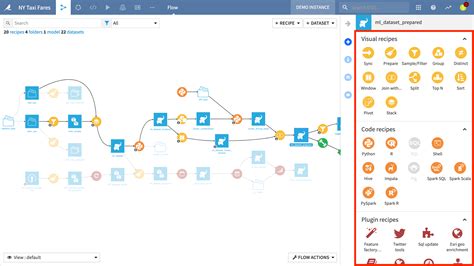Dataloop: Merging Datasets – A Recipe for Success
Data scientists and machine learning engineers frequently work with multiple datasets that need to be combined for analysis or model training. Dataloop, a powerful platform for managing and versioning datasets, offers several effective ways to merge your datasets. This post explores different recipes for merging datasets within Dataloop, emphasizing best practices for efficient and accurate data integration.
Understanding Your Data Before Merging
Before diving into the merging process, it's crucial to understand the structure and content of your datasets. Key considerations include:
- Data Types: Ensure consistent data types across columns intended for merging. Discrepancies can lead to errors.
- Key Columns: Identify the columns that uniquely identify rows (primary keys) or relate rows across datasets (foreign keys). These are essential for accurate joins.
- Data Cleaning: Address missing values and inconsistencies within your individual datasets before merging. This prevents propagating errors into the merged dataset.
- Dataset Sizes: Very large datasets can require careful planning and potentially optimized merging strategies.
Dataloop's Merging Strategies: A Recipe Guide
Dataloop provides flexibility in how you merge your datasets. Here are some common approaches:
1. Concatenation (Append): Adding Datasets Vertically
This is ideal when you have multiple datasets with the same schema (columns) and you simply want to combine them vertically, adding rows. Imagine you have daily sales data in separate files; concatenation is perfect for combining them into a single dataset representing all sales.
- Advantages: Simple, fast for datasets with identical schemas.
- Disadvantages: Not suitable for datasets with different schemas or when relationships between datasets need to be preserved.
2. Joining (Merge): Combining Datasets Based on Relationships
Joining is the most versatile approach, allowing you to combine datasets based on shared columns (keys). This is ideal when you have related data spread across different tables – for example, combining customer information with their order history. Dataloop supports different join types:
-
Inner Join: Only includes rows where the key exists in both datasets.
-
Left Join: Includes all rows from the left dataset, even if the key doesn't exist in the right dataset (NULL values for unmatched columns in the right dataset).
-
Right Join: Similar to left join, but includes all rows from the right dataset.
-
Full Outer Join: Includes all rows from both datasets.
-
Advantages: Preserves relationships between data from multiple sources. Offers flexibility with various join types.
-
Disadvantages: Can be slower than concatenation, requires careful selection of key columns.
3. Using Dataloop's Built-in Functions (Advanced Recipes)
Dataloop may offer built-in functions or integrations that streamline dataset merging. These often leverage optimized algorithms for speed and efficiency. Check the Dataloop documentation for updates on available features. This is often the most efficient approach for large datasets.
- Advantages: Optimized for speed and efficiency, often handles complexities automatically.
- Disadvantages: Requires familiarity with Dataloop's specific functions and capabilities.
Best Practices for Merging Datasets in Dataloop
- Version Control: Always track versions of your datasets before and after merging. Dataloop's version control helps you revert to previous versions if needed.
- Data Validation: After merging, validate the resulting dataset to ensure accuracy and consistency.
- Documentation: Thoroughly document the merging process, including the method used, key columns, and any data transformations.
Conclusion: Crafting the Perfect Data Merge
Mastering the art of dataset merging in Dataloop unlocks the potential of your data. By understanding your data's structure and selecting the appropriate merging strategy, you can efficiently combine datasets for insightful analysis and robust model training. Remember to leverage Dataloop's features and follow best practices for a seamless and successful data integration experience.
